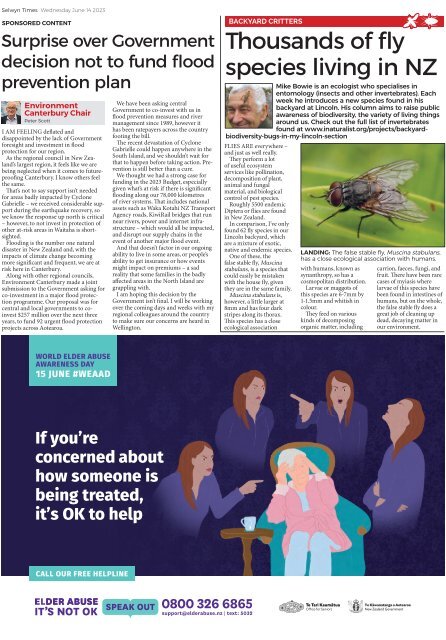Selwyn_Times: June 14, 2023
Create successful ePaper yourself
Turn your PDF publications into a flip-book with our unique Google optimized e-Paper software.
<strong>Selwyn</strong> <strong>Times</strong> Wednesday <strong>June</strong> <strong>14</strong> <strong>2023</strong><br />
SPONSORED CONTENT<br />
Surprise over Government<br />
decision not to fund flood<br />
prevention plan<br />
Environment<br />
Canterbury Chair<br />
Peter Scott<br />
I AM FEELING deflated and<br />
disappointed by the lack of Government<br />
foresight and investment in flood<br />
protection for our region.<br />
As the regional council in New Zealand’s<br />
largest region, it feels like we are<br />
being neglected when it comes to futureproofing<br />
Canterbury. I know others feel<br />
the same.<br />
That’s not to say support isn’t needed<br />
for areas badly impacted by Cyclone<br />
Gabrielle – we received considerable support<br />
during the earthquake recovery, so<br />
we know the response up north is critical<br />
– however, to not invest in protection of<br />
other at-risk areas in Waitaha is shortsighted.<br />
Flooding is the number one natural<br />
disaster in New Zealand and, with the<br />
impacts of climate change becoming<br />
more significant and frequent, we are at<br />
risk here in Canterbury.<br />
Along with other regional councils,<br />
Environment Canterbury made a joint<br />
submission to the Government asking for<br />
co-investment in a major flood protection<br />
programme. Our proposal was for<br />
central and local governments to coinvest<br />
$257 million over the next three<br />
years, to fund 92 urgent flood protection<br />
projects across Aotearoa.<br />
We have been asking central<br />
Government to co-invest with us in<br />
flood prevention measures and river<br />
management since 1989, however it<br />
has been ratepayers across the country<br />
footing the bill.<br />
The recent devastation of Cyclone<br />
Gabrielle could happen anywhere in the<br />
South Island, and we shouldn’t wait for<br />
that to happen before taking action. Prevention<br />
is still better than a cure.<br />
We thought we had a strong case for<br />
funding in the <strong>2023</strong> Budget, especially<br />
given what’s at risk if there is significant<br />
flooding along our 78,000 kilometres<br />
of river systems. That includes national<br />
assets such as Waka Kotahi NZ Transport<br />
Agency roads, KiwiRail bridges that run<br />
near rivers, power and internet infrastructure<br />
– which would all be impacted,<br />
and disrupt our supply chains in the<br />
event of another major flood event.<br />
And that doesn’t factor in our ongoing<br />
ability to live in some areas, or people’s<br />
ability to get insurance or how events<br />
might impact on premiums – a sad<br />
reality that some families in the badly<br />
affected areas in the North Island are<br />
grappling with.<br />
I am hoping this decision by the<br />
Government isn’t final. I will be working<br />
over the coming days and weeks with my<br />
regional colleagues around the country<br />
to make sure our concerns are heard in<br />
Wellington.<br />
BACKYARD CRITTERS<br />
Thousands of fly<br />
species living in NZ<br />
Mike Bowie is an ecologist who specialises in<br />
entomology (insects and other invertebrates). Each<br />
week he introduces a new species found in his<br />
backyard at Lincoln. His column aims to raise public<br />
awareness of biodiversity, the variety of living things<br />
around us. Check out the full list of invertebrates<br />
found at www.inaturalist.org/projects/backyardbiodiversity-bugs-in-my-lincoln-section<br />
FLIES ARE everywhere –<br />
and just as well really.<br />
They perform a lot<br />
of useful ecosystem<br />
services like pollination,<br />
decomposition of plant,<br />
animal and fungal<br />
material, and biological<br />
control of pest species.<br />
Roughly 5500 endemic<br />
Diptera or flies are found<br />
in New Zealand.<br />
In comparison, I’ve only<br />
found 62 fly species in our<br />
Lincoln backyard, which<br />
are a mixture of exotic,<br />
native and endemic species.<br />
One of these, the<br />
false stable fly, Muscina<br />
stabulans, is a species that<br />
could easily be mistaken<br />
with the house fly, given<br />
they are in the same family.<br />
Muscina stabulans is,<br />
however, a little larger at<br />
8mm and has four dark<br />
stripes along its thorax.<br />
This species has a close<br />
ecological association<br />
LANDING: The false stable fly, Muscina stabulans,<br />
has a close ecological association with humans.<br />
with humans, known as<br />
synanthropy, so has a<br />
cosmopolitan distribution.<br />
Larvae or maggots of<br />
this species are 6-7mm by<br />
1-1.5mm and whitish in<br />
colour.<br />
They feed on various<br />
kinds of decomposing<br />
organic matter, including<br />
carrion, faeces, fungi, and<br />
fruit. There have been rare<br />
cases of myiasis where<br />
larvae of this species have<br />
been found in intestines of<br />
humans, but on the whole,<br />
the false stable fly does a<br />
great job of cleaning up<br />
dead, decaying matter in<br />
our environment.<br />
WORLD ELDER ABUSE<br />
AWARENESS DAY<br />
15 JUNE #WEAAD<br />
If you’re<br />
concerned about<br />
how someone is<br />
being treated,<br />
it’s OK to help<br />
CALL OUR FREE HELPLINE


















